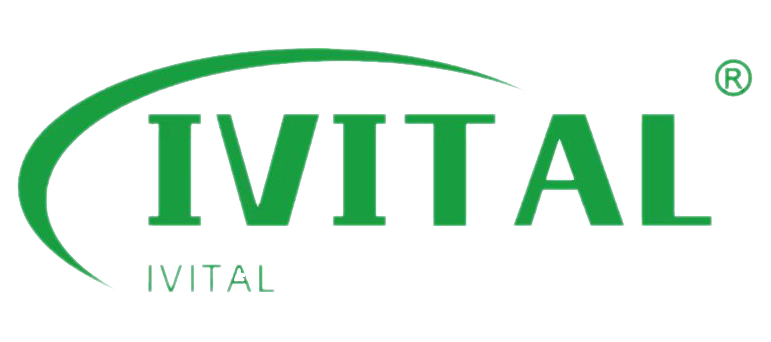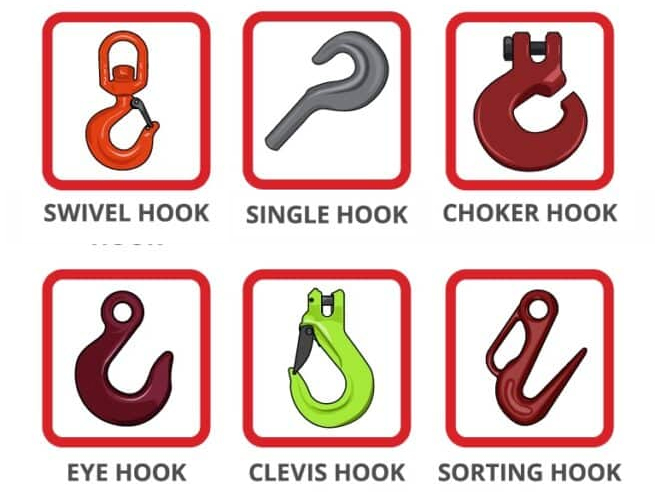Are you getting ready to do some overhead lifting and you need to specify the type of sling and rigging hardware you’ll be using? While it’s important to know the best type of sling to use, it’s just as important to select the right type rigging hardware that will be connected to that sling. The type of lifting hook you can use will be determined by a number of different factors.
In this article, we’ll talk about the different type of sling hooks that exist, including: eye hooks, clevis hooks, swivel hooks, hooks with latches, sorting hooks, foundry hooks, j-hooks, grab hooks, and barrel hooks.
To pick the right type of sling assembly for your future lifting and rigging needs, you need to know:
- How much the load weighs
- What kind of load or material you’re lifting
- What kind of sling you’re using
- What kind of sling hitch you’re using
- How you’re connecting to the load – are you using shackles or does the load have engineered lifting points?
- How many lifting points there are and how far apart they are
- What the sling angle is
Ivital offers all types of lifting slings, rigging hardware, wire rope, overhead cranes and hoists, hoist parts, and engineered below-the-hook lifting devices. We want to help you choose the right type of sling assembly for your future lifting and rigging needs.
If you’d like more information on the pros and cons of wire rope, chain, and synthetic slings, we also have an article on how to choose the best lifting sling for your application.
Types of Lifting Hooks: Eye Hooks, Clevis Hooks, and Swivel Hooks

There are two main ways to attach a lifting hook or sling hook to a sling. You can use a hook with an eye at the top or a hook with a clevis at the top to make your connection to the sling. There are also hooks that have a bearing or bushing at the top that swivels. We’ll go into more detail on all three of these styles below:
Eye Hooks
You weld a chain or fittings to an eye hook to make a permanent connection to the sling. With an eye hook, you have a lot more freedom to move and position the hook and attach it to the load in a way that’s ergonomic. However, an eye hook is a permanent solution—if the throat of the hook gets stretched, cracked, or bent during use, you’d have to fail the whole sling upon inspection and take it out of service.
Clevis Hooks
A clevis fastener is a fastener system that consists of a clevis and clevis pin. The clevis is a U-shaped piece that has holes at the end of the prongs to accept the clevis pin. The clevis pin is similar to a bolt, but it’s only partially threaded or unthreaded with a cross-hole for a split pin. A clevis hook is a hook, with or without a snap lock, with a clevis and bolt or pin at the base. The clevis is used to fasten the hook to a bracket or chain.
Some riggers and end users who are not certified to weld alloy chain slings, use clevis hooks to make a mechanical connection to a chain sling. The advantage of a mechanical connection is that if a clevis hook becomes damaged due to stretch, bending, or cracking, it can easily be removed and replaced without scrapping the entire chain sling. If this occurs on a chain sling, this is considered a repair to the sling and must be proof-tested prior to the sling being put back into service.
Also, a clevis hook can pivot side to side for positioning when connecting to a load, but doesn’t have the same flexibility or freedom of movement that an eye hook does.
Swivel Hooks
There are two types of swivel hooks and you need to know which type you have before you lift a load:
- Positioning Swivel Hook – This hook swivels so you can align the hook properly when you connect it to the load. This hook is NOT designed to rotate while you are lifting a load. You use this hook when you need to position the hook onto the pick point.
- True Swivel Hook with Bearing – This hook has a bearing inside the hook that allows the hook to rotate freely while you are lifting a load. The top fitting swivels and pivots so the load can rotate to prevent the rigging from twisting.
Lifting Hooks With Latches
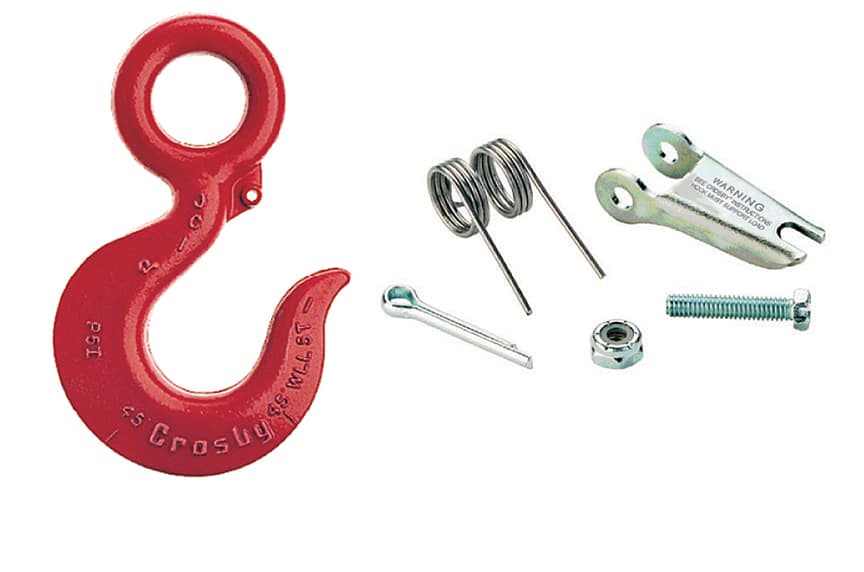
When you’re deciding whether or not to use a hook latch, you need to think about the specific lifting application. The use of latches on hooks is a topic that is constantly up for debate in the lifting and rigging industries. Some people say that hook latches are always required and should always be used. Others say that latches are not required.
Unfortunately, there are no explanations or interpretations of when a latch on a hook must be used. There are no industry-wide rules on whether a hook latch is required on a crane hook or a sling hook. It’s up to the owner or end-user to decide.
IVITAL recommends using hook latches. When we train our people and our inspectors on the use of hook latches, we take all of the following into consideration:
- Any hook that is designed to have a latch, should have the latch installed
- New slings are sold with the latch installed unless the customer requests no latch
- If customers make an inquiry about the use of a latch on a hook, we may recommend for them to consider several OSHA standard interpretations, among them the following:
- The Occupational Safety and Health Act of 1970 also says that if OSHA doesn’t have a specific standard for a hazard, employers have to protect employees from serious recognized hazards under the statute’s “General Duty Clause” (Section 5(a)(1)). OSHA often looks at industry consensus standards, like those published by the American National Standards Institute (ANSI) or the American Society of Mechanical Engineers (ASME), to decide if a hazard is “recognized” and if there’s a way to get rid of it.
- One of those standards OSHA might look at is Section 2-1.14.5, Hooks, in ASME B30.2- 2001, Overhead and Gantry Cranes: “Latch-equipped hooks shall be used unless the application makes the use of the latch impractical or unnecessary.”
- Or you might see this OSHA standard interpretation: The requirement for safety latches (AKA throat latches) is only spelled out in OSHA 1910.181(j)(2)(ii), which says “Safety latch type hooks shall be used wherever possible.”
- Or you might see this OSHA standard interpretation: Whether OSHA requires a safety latch on a sling hook depends on what you’re doing with the sling.
We suggest that you evaluate the work you’re doing to determine if it’s safe for your people. If it’s not practical, not necessary, or more dangerous to use the latch, then you can take the latch off. I also recommend that you look at each lift you make and consider whether or not you need to use the latch on the hook.
Sling Hooks With Self-Closing Latch Kits

All hook manufacturers make hooks with and without latches. Some hooks are compatible with self-closing latch kits so that you can put a latch on at the time of the sale or after the sale.
There are two types of hooks that you rarely put a latch assembly on because of the nature of the lift or the environment where the lift is being performed:
- A sorting hook doesn’t use a latch kit. They’re typically used for lifts with tip loading or where a latch would get in the way when lifting plates and cylindrical loads (like pipe) where you need to get the full throat engagement.
- A foundry hook doesn’t use a latch kit much because they’re used in environments or applications where it’s dangerous for a worker to reach up to connect the load or remove the load from the hook.
The one downside to a hook with a self-closing latch is that they don’t last as long as a positive latching hook. One thing to consider when buying a hook with a latch kit is to understand if it’s an imported or domestically-made product.
Imported rigging products are attractive because they’re often cheaper than a domestically-made product. However, if the latch breaks on an imported hook, it can be very hard, or expensive, to find a replacement latch kit. You may even wipe out the initial cost-savings by having to buy a completely new hook because you can’t source the replacement latch kit.
For domestically-made hooks, you can call the manufacturer or distributor directly and they can give you the exact replacement latch kit part # and get you a replacement kit at a fraction of the cost of a new hook.
Positive Latching Hooks

A positive latching hook is a hook with a latch that is a more robust and engineered component of the hook. The advantage of a positive latching hook is that it’s nearly impossible to break the latch on these hooks and once it closes, it can’t open again until the load is released from the hook.
These types of hooks are close to standard on chain slings because they’re more robust and can handle heavier-duty environments and lifts where chain is the preferred sling medium.
Sorting Hooks
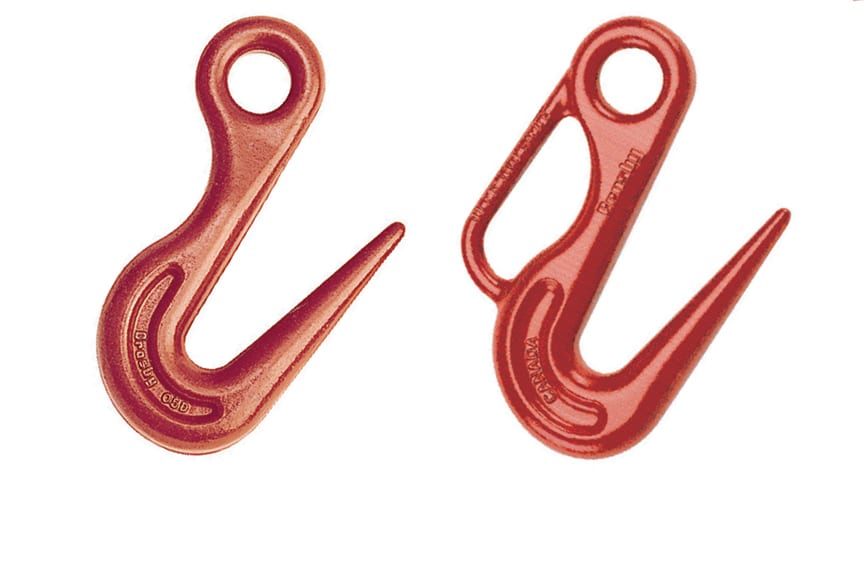
Sorting hooks, also called “lay out hooks” or “shake out hooks,” are used to sort or lay out products like flat plate, pipes, or other tube-shaped objects. They’re used in multi-leg sling assemblies for applications where the object or item will engage to the full depth of the throat of the hook.
Sorting hooks must be used at a 30° to 45° angle to get full engagement—if the load is not fully engaged with the throat opening, significant reduction to the Working Load Limit of the hook can occur.
Sorting hooks are one of the few types of hooks designed not to use a latch. The use of a latch would limit the practical use of the hook when lifting plates and cylindrical loads where full throat engagement of the hook is required.
A sorting hook is NOT the same as a pelican hook. Many customers mistakenly refer to a sorting hook as a “pelican hook.” However, pelican hooks are used in nautical and marine applications and are not rated to perform overhead lifts.
Foundry Hooks

Foundry hooks are used on chain slings and are designed with a wide deep throat to fit trunnions and handles on molds or castings for foundry work.
Foundry hooks are usually designed to be used without a latch, because they’re often used in high-heat applications where it’s dangerous for a human to reach up to connect or remove the load from the hook.
Because of the environments they’re used in, foundry hooks are often used in applications where tip loading is necessary. The user should be aware that the Working Load Limit is reduced during tip loading and should always ensure the load is retained properly in the hook. Always refer to the manufacturer’s specific guidelines for W.L.L. reduction.
Grab Hooks
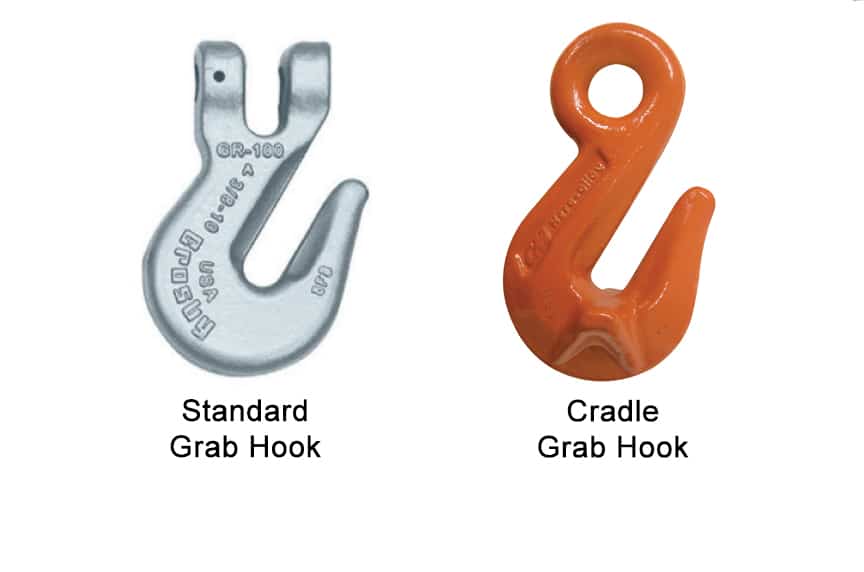
Grab hooks are made with a special narrow throat used to “grab” and shorten or hold a length of chain used in tie-down applications and in load-rated lifting slings. The throat grabs the chain between the links for quick non-slip handling. Grab hooks are made to be used with a specific size and grade of chain. There are two types of grab hooks, so you need to know what type of grab hook you’re using before you lift a load into the air:
- Standard grab hook – Not as common, the “non-cradle” grab hook is most often seen in tie-down applications. When you use a standard style grab hook, you need to be aware of any reductions in working load limit (WLL) that the hook manufacturer may require based on usage configuration. When you use a “standard” grab hook, most manufacturers require a reduction of 20% of the WLL.
- Cradle grab hook – The “cradle style” is replacing the “non-cradle” or “standard” grab hook for most applications due to its improved support of the engaged chain link. This additional support of the engaged link often means there is no reduction of working load limit (WLL) when used as designed. Always follow manufacturer recommendations for all lifting products.
Drum / Barrel Hooks
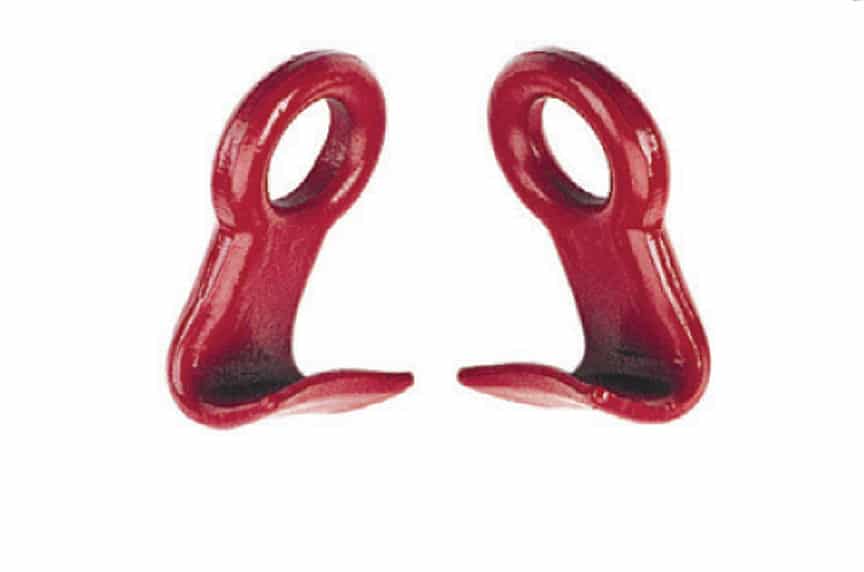
Barrel Hooks are used to pick up barrels or drums. They have a wide end that goes under the lip of a barrel or drum and are used with a multi-leg sling assembly. Usually used with a pair of slings and are designed to be used at 30-45° angles.
Wrapping it Up
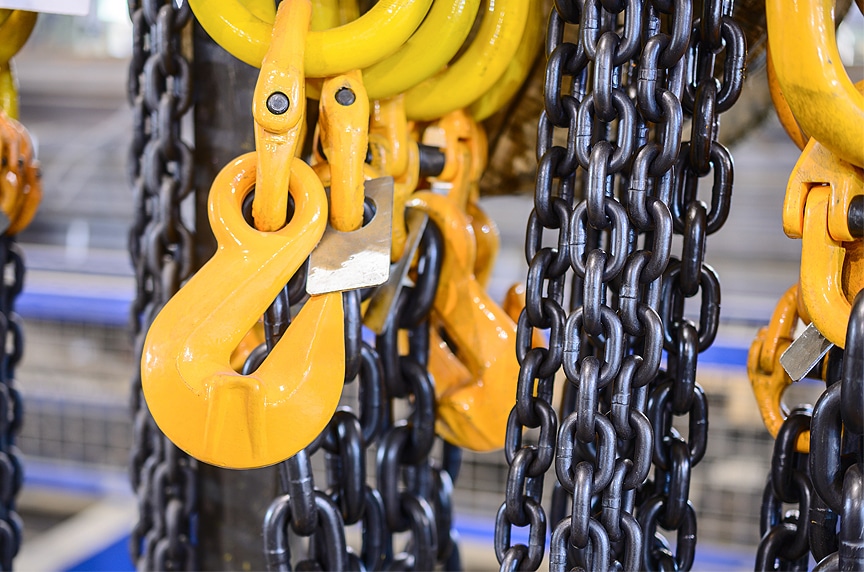
When you’re trying to figure out what kind of hook to use for an overhead lift, the first thing you need to ask yourself is, “how am I connecting to the load?” Is the load going to have eye bolts, swivel hoist rings, engineered lifting points, or are you going to use shackles to connect the hook to?
You also need to know:
- The total weight of the load
- The type of sling you’re using
- The type of sling hitch you’re using
- The angle of the sling
Once you have that information, you can go to a reputable rigging shop, or rigging equipment supplier, and they can help you figure out what kind of hooks you need to use. They’ll make sure that the design of the hook and its Working Load Limit is adequate for the lifts you’re going to be doing.
At IVITAL, we work with all of the major rigging hardware suppliers in the industry. We can quote and fabricate sling assemblies or get you the individual slings and hardware you need to put them together yourself.
